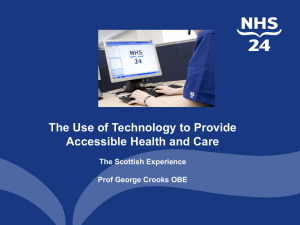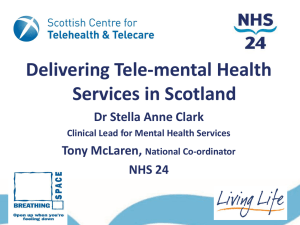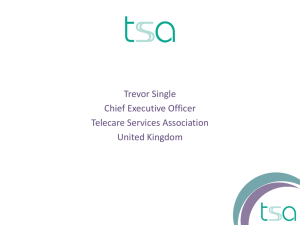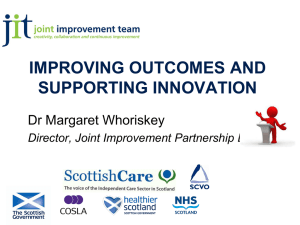Telecare in Wales
advertisement
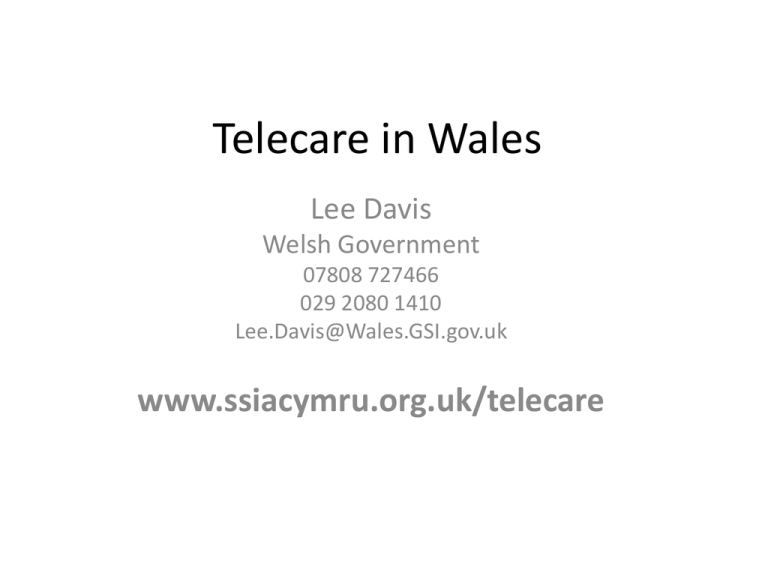
Telecare in Wales Lee Davis Welsh Government 07808 727466 029 2080 1410 Lee.Davis@Wales.GSI.gov.uk www.ssiacymru.org.uk/telecare Why is there so little Telehealth ? Wales • Population under 3 million • 22 Local Authorities • 7 LHBs • All Co-Terminus with one or more local authority So : • Regionalisation • Pooled Budgets Welsh ‘Call Centres’ In 2006 • 22 (23?) call centres mostly only 5,000 connections • Only one with over 10,000 connections • Every LA had one • Costs not known • Value not known • Potential not understood Regionalisation • North Wales Regional Telecare Service • 6 local authorities and one LHB working through one call centre (admittedly on two sites) • South East Wales Improvement Collaborative (SEWIC) • 10 Local Authorities and 3 LHBs • Encompassing Gwent Frailty Project • Carmarthenshire & Hywell Dda RCT Sustaining Social Services – A Framework for Action • • • • Regionalisation Cost Integration of Telecare & Telehealth Links with ICES Telecare to Manage Risk Environmental And Security Social Medical Cardiac arrest Fire Flood Nutrition Cognition Medication Gas Intruders Mobility Asthma attack A Robust Business Case !? A telecare enhanced care package is on average cheaper to social services than residential care only if the package is less than about 20 hours per week… A Robust Business Case !? Random Sampling: Where institutional care is avoided social care costs were on average reduced by £216 per week Where telecare can mean a reduced care package at home the cost avoidance is on average £257 per week A Robust Business Case !? In one county studied: Weekly cost of providing telecare service is under £9 per user per week – elsewhere probably £12-£15 Across Wales: On average 3.29 hospital bed days per year per client – a weekly saving of £14.12 per client John Bolton’s Work for SSIA • List of 31 things that local authorities should do to save money • Telecare is Number 2 on that list • After Re-ablement ( – which it can support) A Robust Business Case !? Conclusion The potential for a well targeted telecare service to reduce costs for social services is substantial A Robust Business Case !? Conclusion Telecare is not a cost saving panacea Telecare was developed to manage the risks associated with independent living, to contribute to people’s health, mobility, social well-being and security, and ultimately to provide choice This should remain its primary goal People Receiving Telecare at midnight on 31December 2009 17,946 Total Telecare Service Delivery = 19,699 Community Alarm users = 100,000 approx Home Care Service Users in any given week = 23-24,000 Would you describe your telecare service as mainstreamed? Yes = 20 (17) No = 2 (5) (15) (7) Telehealth • We don’t Know how many – counting them now But Carmarthenshire RCT = 240 • Main supplier of Telehealth packages in Wales say that through the Telecare Capital Grant they sold .... 86 !! Community Alarms They used : POTS (plain old telephone system) systems Personal Contacts Existing Social Alarm Monitoring Monitoring Centre Emergency Services Passive/Reactive Telecare It is still : POTS (plain old telephone system) systems Personal Contacts Passive Sensors in the home.. Monitoring Centre Emergency Services Alarms – A Reactive Telecare System Wireless alarm Advanced Lifeline Unit Smart Sensors Relatives & friends Duty Social Worker Out-of-hours Mobile Warden GP 24 Hour --Nurse 24 hour Gas fitter Response Team Rapid Response Team Lifting service Community Alarm Centre Fire service Emergency plumber Police Ambulance 24 hr. Home Care Contact & Coordination centre Community Alarm Centre Separate Health & Social Care Systems Bloodpressure Cuff Cholesterol Monitor NHS Direct Scales Glucose Sensor Telehealth Care Record Pulse Oximeter Medication Tracking Elderly living independently Healthcare Professionals Home Hub Appliance Community Alarm Centre Home Automation Security Wireless Network • Lights • Doors windows • Motion / Activity • Bed • Drawers • Kitchen • Bathroom Social Worker Emergency Services Coordination Required Care Response Service, Warden etc Family, friends and volunteers Contact & Coordination Centres Potential Roles: • Hospital Discharge • Preventing Admission – co-ordinating services to support at home • Real Time updating and communication of care plan • Changing the care package – Responsive. Telehealth: • Installation, Maintenance, Administration • Traffic Light System means clinical involvement only at last point of process • This is Mainstreaming Technology !!! Integration of Services Cost-effectively County 1 County 2 Home Response Response Team 1 Coordination & Contact centre 8am–6pm Mon - Fri 8am–6pm Mon - Fri TELECARE MONITORING CENTRE 24/7 Response Team 4 Coordination & Contact centre 8am–6pm Mon - Fri County 4 Coordination & Contact centre Clinic Response Team 3 Response Team 2 Coordination & Contact centre 8am–6pm Mon - Fri County 3 Telehealth on a Telecare Platform • We are ready • Seize the moment with the LHBs & Regional partnerships • The technology enables us to provide telehealth monitoring services and telecare alarm services alongside. • We need to be proactive and not miss this opportunity to provide truly integrated services Cottage Industry Thinking • How far away are we from turning ‘Community Alarm Services’ in to ‘Contact & Co-ordination Centres‘ which can co-ordinate the delivery of integrated health and social care services • We are so far away that Care Line’ services are not being informed when service users are in care homes or hospital. Many have no idea where users are unless an alarm goes off • Does all the required service user information go in to the service? • Does all the call centre’s knowledge of service users’ needs & history inform how you can maintain people’s independence. • Are the ‘Call Centres’ really full players in the delivery of health & social services • Are they really part of the mainstream? • Or are they are still a ‘one-trick-pony’ re-active service? What We Know & What We Need Communication Hubs 3 Functions 3 Contexts Library Function Call Handling Care Coordination National Regional Local Framework of Services for Older People – 2011 • The focus of this ‘Framework of Services for Older People’ will be upon how these public services work together to promote the independence of frail older people either in their own homes or in other homely settings. It will contribute to the achievement of modern, accessible and responsive services capable of meeting people’s needs and of being delivered flexibly, consistently and sustainably across organisational boundaries. In addition to enabling people to live as independently as possible, services must assist them to recover independence where this has been threatened, must promote and protect their dignity, must promote social inclusion, must support them at times of difficulty and protect them from harm. Framework of Services for Older People – 2011 The word ‘Telecare’ appears 51 times Framework for Telecare • Within the next few months the Welsh Government will be publishing updated guidance that will build upon lessons learned over the past five years and will continue to promote the strategic development of this service. The guidance will be directed towards ensuring that we make the best use of telecare and realise the benefits of closer integration with other services such as telehealth, community equipment, adaptations, etc. We also need to exploit the potential of the communications centre at the heart of telecare to provide more effective services. The Social Care Battleground Question: What will prevail? -Short term survivalism or long term sustainability. Answer: Organisations will need to work together in partnership and with innovation if we are going to meet the challenge to demonstrate that preventative services are more efficient in the long run What We Know & What We Need The Sustainability & Mainstreaming of Telecare depends upon the development of a national comprehensive care strategy that embeds telecare into health, housing and social care services What We Know & What We Need Pooled Health & Local Authority Budgets to • Purchase telecare and telehealth equipment • Integrated data collection & management • Co-supervision of telecare and telehealth What We Know & What We Need National/Regional purchasing strategies with clear specifications to secure better products from suppliers A full-time professional in charge of Telecare / Telehealth regionally. With a level of authority and skills What We Know & What We Need Better and more consistent training for users, referrers and assessors Fully dedicated assessors Charging policies that remove perverse incentives – public/private funding strategy ? A Robust Business Case Why is Telehealth Delivery so low ? • This presentation has concentrated on the supply side • And the received wisdom is that we need get clinical involvement (esp. GPs) to work through telehealth • Why aren’t clinicians flocking to it? • Is it because health care is still too Hospital based> • But is there a nightmare scenario that service user (patient) demand is low ?? – have we measured it? • Is it that telecare is still too ‘cottage industry’ to help? • Is it that Health & Social care are still not able to work together? • Or is it just the stage we are at? Telecare in Wales Lee Davis Welsh Government 07808 727466 029 2080 1410 Lee.Davis@Wales.GSI.gov.uk www.ssiacymru.org.uk/telecare

